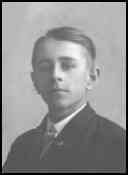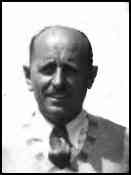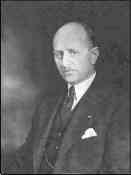


| WALTER E. LEES 1889-1957 |
 |
 |
 |
| Walter E. Lees, 1904. | Walter E. Lees, 1931. | Walter E. Lees, 1957. |
|
I hope you enjoy your visit and will come back here for more on the other pioneer aviators. |
|
Brief Chronological Summary of Events, 1887-1957 1887 Walter E. Lees was born July 16, 1887, at Janesville, Wis., and attended the University of Wisconsin. He was a natural mechanic in his youth and quite an expert with autos. 1911 He saw his first aeroplane when Curtiss Pilot Beckwith Havens flew at the Ashland, Wisconsin Fair on September 13-14, 1911. Lees was so thrilled with the idea of flying that he enrolled for instruction that fall with the Aero Exhibition Co. of Chicago. The group left Chicago for St. Augustine, Florida, on December 9, 1911. This was reported to be a school where he could earn part of his tuition working as a mechanic, but it proved to be a hoax. Lees received no instruction, but after several weeks of hard work, he did get one three-minute aeroplane ride with Otto Brodie in a Gnome motored Farman Biplane. 1912 Disappointed, he had to work and earn some money before he could get back north in the spring of 1912 to join the Benoist Co. in St. Louis as an aviation mechanic. After working for the Benoist Co. through the summer, Lees started going out on exhibition dates that fall with Company aviators, Tony Jannus, William Bleakley and Ray Benedict. Lees was so eager to learn to fly that Jannus was giving him a little instruction when time allowed on these trips. He made his first solo "accidentally on purpose" on November 14, 1912, at Creve Coeur Lake, Mo. While taxiing a Benoist Hydro faster than he should, it suddenly jumped off the water and he found himself about 50 feet in the air before he realized what was happening. He kept his head, however, and landed it safely but was severely criticized for doing it. With some additional help, he did succeed in making a little progress toward learning to fly that fall. That winter, Lees went back to St. Augustine as a mechanic with Ray Benedict to fly resort exhibitions 1913 . He remained there until nearly spring, of 1913, when he returned to Benoist as a mechanic. That summer, he did some more flying, but toward fall he decided he was not getting any place at Benoist, so left and went to Chicago, where he took up selling. The urge to really become an aviator was as strong as ever, and selling did not appeal to him. 1914 He wanted to take a good flying course, so after saving his money through 1914, he enrolled for a flying course at the Curtiss Flying School, North Island, San Diego, Cal., and was a student in the winter class starting late in December, 1914. 1915 His instructor was Raymond V. Morris, and he received his Curtiss diploma on February 1, 1915. Later, he accepted an offer to fly a Curtiss flying boat for Stewart McDonald in Chicago, arriving there in May, 1915. That summer, Lees carried many passengers at Grant Park and at Lake Geneva, Wisc., for McDonald. On August 2-7, he was a contestant in a local Air Meet at Grant Park, and also made his first night flight at Chicago with two spot lights attached to his boat. In September, 1915, he joined the Curtiss Co. as an instructor on Model F Boats at Buffalo, N.Y. There he took his tests for a Flying Boat license and passed, obtaining license No. 44, with Dr. Albert Zahn and Charles Manly as his official observers. When the Curtiss Co. opened its school at Newport News, Vas., in December, 1915, Lees was sent down, first as a flying boat instructor, then later on land planes. This school was known as the Atlantic Coast Aeronautical Station, and was under the management of Capt. Thomas S. Baldwin, veteran airman and close friend of Glenn Curtiss. This field soon became a major Curtiss training center, and consisted of a dirt strip about 200 feet wide and 3,000 feet long, with some old buildings and good water frontage. At its height, seven instructors used it from daylight till dark (except Sundays) without serious mishaps. many of the students were Canadians, sent down by the Government for flight training. After completing their course, they usually returned to Canada and joined the R.A.F. Also trained were numerous U.S. National Guardsmen and Army Reserves. 1916 The class, as a rule, consisted of thirty or more, and in the early spring of 1916, Lees assisted in the instruction of Vernon Castle, the well known dancer, as well as Maj. Wm. Mitchell, who was taking lessons on weekends as a civilian, while stationed in Washington, D.C. Later, he personally soloed Gen. Mitchell during the spring months of 1916. On March 10, 1916, he flew a Curtiss Flying Boat with an OX engine, from Newport News, Va. to Washington, D.C., carrying Charles Pond as a passenger, making one stop at Lewisetta, Va. for gas. He remained in Washington for about two weeks, flying for the Curtiss Co., then flew back to Newport News. He was an instructor at Newport News through 1916 and into 1917, when, 1917 On February 21, 1917, he obtained his regular Pilot License, No. 660, and then on March 21, his Expert Pilot License, No. 79. When World War I broke out, Lees answered the call for civilian instructors. He finished the last eight months of the war as an experimental test pilot at McCook Field, Dayton, Ohio. 1919 After the War was over, he returned to Curtiss until October, 1919, as a test and demonstration pilot and instructor. He also assisted with the developement of several new planes the Company brought out for the commercial market immediately after the war. Following this, he was sent with two other pilots, J. D. Hill and Victor Vernon, to establish a Curtiss Agency in the northwest at Portland, Oregon. He flew all over Oregon, Washington and Idaho in land planes, and in water craft on the Columbia River, 1920 Lees left Curtiss in February, 1920, to become manager of the LaGrande Aircraft Co., LaGrande, Ore., and to do cross country flying and exhibition work. 1921 In May, 1921, he left Oregon and returned to Wilbur Wright Field, Dayton, Ohio. 1922 He joined the Dayton-Wright Aeroplane Co. staff as Instructor-Pilot. That fall, he became affiliated with the Johnson Aeroplane Supply and Flying Service in Dayton as pilot-instructor. They ran a flying school, did cross country work, bought and sold aeroplanes, also designed and built a few experimental planes of their own. While in their employ, he was a contestant in the various annual Air Races of that period, usually with OX powered planes. In 1923, he won the Flying Club Trophy at St. Louis, Mo. 1924 In 1924, he won the National Cash Register Trophy at Dayton, Ohio. At Johnson Field, Dayton, on May 13, 1924, Lees joined the Caterpillar Club, No. 9, when he had a very narrow escape flying an overhauled second hand German L.V.G., World War I aeroplane. He had made several flights in this plane before and liked it. For no particular reason, except that he had it, he put a chute on and took off. As soon as he was airborne, he was in real trouble. By using all the control he had in one direction, he managed to make a circle and head into the field for a landing,. but the instant he throttled back, the plane went completely out of control. He knew he had to use the chute. Since he did not have enough altitude to jump, he slid up in the seat, pulled the ring and let the chute pull him out. He was so low that his side hit the ground on the first swing of the chute and he sustained a leg and hip injury which caused him considerable trouble the rest of his life. The plane crashed and was badly wrecked less than 100 feet from where he landed. He was the first Early Bird to join the Caterpillar Club. He remained with the Johnson Flying Service through 1924, then joined the Packard Motor Car Co., Detroit, as Chief Test Pilot on their Diesel Aircraft Engine developement program, the first of its kind in the United States. There he did a tremendous amount of developement tests and sales promotional flying in the next few years, in an effort to make this project a success. He also made several notable long cross-country flights. 1929 He competed in the Ford Reliability Tours with Packard Diesel powered planes during 1929, 1930 and 1931. 1931 On May 30, 1931, he and Fred A. Brossy completed a new World non-refueling duration record of 84 hours, 33 minutes, with a Packard Diesel-powered Bellanca monoplane, at Jacksonville, Fla., nine hours better than the previous record. 1935 After the Packard Co. had abandoned the Diesel engine project, Lees joined the Scintilla Magneto Div. Bendix Aviation Corp., Sidney, N.Y., as Sales Engineer. 1940 At the end of World War I, Lees became a Lieutenant in the Army Air Service Reserves, then later transferred to the Navy, advancing to Commander. In December, 1940, he was called to active duty in the Naval Air Service. He had been active in aviation for 35 years, during which time he had flown over 12,000 hours and handled some 60 different types of planes. 1946 Lees retired as Naval Commander in September, 1946, and settled on a small two-acre ranch at Turlock, California, to enjoy the quiet contentment of home life. 1957 After a prolonged illness, he passed away at Travis Air Force Base Hospital on May 16, 1957, at the age of 69. Walter Lees loved aviation and never lost the thrill of flying. He was always a gentleman and his ever ready smile endeared him to all. He was well known and loved for his congenial and courteous manner. As an expert pilot with a sound engineering understanding of all phases of aviation, he was an active member of the Early Birds, Old Birds, Quiet Birdmen and Caterpillar Club, truly one of the real flying pioneers of aviation. Kindly provided by Jack L. Detour. 30 April, 1998 |
|
|
 |
Based on Walter E. Lees' Journals 1911 to 1931 Edited by Jo Cooper Product Details Paper: 162 pages; 8 1/2x11 inches List Price: $20.00 ISBN: 0-9638147-0-2 |
|
Description: Pioneer Pilot, a personal account of the early years of aviation, is based on the 1911-1931 journals of Walter E. Lees, an "Early Bird". Like many other mechanics, engineers, and flyers of those early days, Lees is an unsung hero. A Wisconsin farm boy, Lees was determined to fly. And fly he did - soloing Billy Mitchell, checking Lindbergh out on a diesel, and in 1931, setting an endurance record which stood until the Voyager's flight in 1986. Besides Lees' journals, the author has included newspaper reports, letters, and interviews with friends, associates, and Lees' wife, Loa, who regularly packed up their ever-growing family and household to follow him and his dream all over the country. Also included are many never before published photographs. This book is a must for aviation buffs as well as those who enjoy stories of endurance and courage fulfilled. |
|
Comdr. Walter E. Lees, USNR, (ret.), who spent a lifetime in aviation, died at Travis Air Force Base Hospital on May 16, 1957. Funeral services were held at Norton's Mortuary, Turlock, California, the city of his residence, May 21st. Early Birds were represented by Mr. and Mrs. Robert Fowler. Walter was well known to his fellow Early Birds. Following engineering education at the University of Wisconsin, he made his first solo flight on November 14, 1912, near St. Louis, Mo. and continued actively in aviation for over 35 years. During that time, he flew approximately 12,000 hours, handling over 60 different types of planes. After serving for some time as pilot and instructor in private life, he joined the Army Air Service as civilian flying instructor in 1917, and was located at several fields. In the succeeding years, he became affiliated with many companies as pilot, test pilot, instructor, and barnstormer, and he also served as mechanic in the Army Air Service at Wright Field in 1919-1920. Among other things, he and Fred Brossy made a world's non-refueling duration record at Jacksonville Beach, Fla. in 1931 with a flight time of 84 hours and 32 minutes. His service record included five years as pilot in the U.S. Air Service Reserves, some 20 years as pilot in the Naval Air Reserves, and 6 years active duty with the U.S. Navy from 1940 to 1946. He retired from the Navy in 1948 with the rank of Commander. |


|